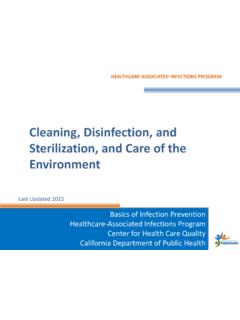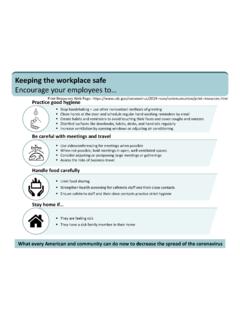Transcription of Cleaning and disinfection of environmental surfaces in the ...
1 Cleaning and disinfection of environmental surfaces in the context of COVID-19. Interim guidance 15 May 2020. Background Coronavirus disease 2019 (COVID-19) is a respiratory buildings, faith-based community centres, markets, infection caused by SARS-CoV-2 (COVID-19 virus). The transportation, and business ,11 Although the precise COVID-19 virus is transmitted mainly through close physical role of fomite transmission and necessity for disinfection contact and respiratory droplets, while airborne transmission practices outside of health-care environments is currently is possible during aerosol generating medical At unknown, infection prevention and control principles time of publication, transmission of the COVID-19 virus had designed to mitigate the spread of pathogens in health-care not been conclusively linked to contaminated environmental settings, including Cleaning and disinfection practices, have surfaces in available studies.
2 However, this interim guidance been adapted in this guidance document so that they can be document has been informed by evidence of surface applied in non-health care setting environments. * In all contamination in health-care settings2 and past experiences settings, including those where Cleaning and disinfection are with surface contamination that was linked to subsequent not possible on a regular basis due to resource limitations, infection transmission in other coronaviruses. Therefore, this frequent hand washing and avoiding touching the face should guidance aims to reduce any role that fomites might play in be the primary prevention approaches to reduce any potential the transmission of COVID-19 in health-care3 and non-health transmission associated with surface care Like other coronaviruses, SARS-CoV-2 is an enveloped virus environmental surfaces in health-care settings include with a fragile outer lipid envelope that makes it more furniture and other fixed items inside and outside of patient susceptible to disinfectants compared to non-enveloped rooms and bathrooms, such as tables, chairs, walls, light viruses such as rotavirus, norovirus and Studies switches and computer peripherals, electronic equipment.
3 Have evaluated the persistence of the COVID-19 virus on sinks, toilets as well as the surfaces of non-critical medical different surfaces . One study found that the COVID-19 virus equipment, such as blood pressure cuffs, stethoscopes, remained viable up to 1 day on cloth and wood, up to 2 days wheelchairs and In non-healthcare settings, on glass, 4 days on stainless steel and plastic, and up to 7 days environmental surfaces include sinks and toilets, electronics on the outer layer of a medical Another study found (touch screens and controls), furniture and other fixed items, that the COVID-19 virus survived 4 hours on copper, 24. such as counter tops, stairway rails, floors and walls. hours on cardboard and up to 72 hours on plastic and stainless The COVID-19 virus also survives in a wide range of environmental surfaces are more likely to be contaminated pH values and ambient temperatures but is susceptible to heat with the COVID-19 virus in health-care settings where and standard disinfection These studies, however, certain medical procedures are Therefore, these were conducted under laboratory conditions in absence of surfaces , especially where patients with COVID-19 are being Cleaning and disinfection practices and should be interpreted cared for, must be properly cleaned and disinfected to prevent with caution in the real-world environment.
4 Further transmission. Similarly, this advice applies to alternative settings for isolation of persons with COVID-19 The purpose of this document is to provide guidance on the experiencing uncomplicated and mild illness, including Cleaning and disinfection of environmental surfaces in the households and non-traditional context of COVID-19. Transmission of the COVID-19 virus has been linked to close This guidance is intended for health-care professionals, contact between individuals within closed settings, such as public health professionals and health authorities that are households, health facilities, assisted living and residential developing and implementing policies and standard operating institution In addition, community settings procedures (SOP) on the Cleaning and disinfection of outside of health-care settings have been found vulnerable to environmental surfaces in the context of COVID-19.
5 COVID-19 transmission events including publicly accessible *. The topics of current WHO interim guidance documents sector,16 aviation sector,17 maritime sector,18 schools,19. for non health care setting environments, including prisons and other places of environmental Cleaning and disinfection recommendations, . This document is not intended to be comprehensive include faith-based community settings,12 funerary guidance on the practice of environmental Cleaning and services,13 workplaces,14 food sector,15 accommodation disinfection , which is covered in other relevant guidelines -1- Cleaning and disinfection of environmental surfaces in the context of COVID-19: Interim guidance Principles of environmental Cleaning and disinfection in a systematic manner to avoid missing any areas.
6 Use fresh cloths at the start of each Cleaning session ( , routine daily Cleaning helps to remove pathogens or significantly reduce Cleaning in a general inpatient ward). Discard cloths that are their load on contaminated surfaces and is an essential first no longer saturated with solution. For areas considered to be step in any disinfection process. Cleaning with water, soap at high risk of COVID-19 virus contamination, use a new (or a neutral detergent) and some form of mechanical action cloth to clean each patient bed. Soiled cloths should be (brushing or scrubbing) removes and reduces dirt, debris and reprocessed properly after each use and an SOP should be other organic matter such as blood, secretions and excretions, available for the frequency of changing cloths.
7 But does not kill Organic matter can impede direct contact of a disinfectant to a surface and Cleaning equipment ( buckets) should be well maintained. inactivate the germicidal properties or mode of action of Equipment used for isolation areas for patients with COVID- several disinfectants. In addition to the methodology used, the 19 should be colour-coded and separated from other disinfectant concentration and contact time are also critical equipment. Detergent or disinfectant solutions become for effective surface disinfection . Therefore, a chemical contaminated during Cleaning and progressively less effective disinfectant, such as chlorine or alcohol, should be applied if the organic load is too high; therefore, the continued use of after Cleaning to kill any remaining microorganisms.
8 The same solution may transfer the microorganisms to each subsequent surface. Thus, detergent and/or disinfectant Disinfectant solutions must be prepared and used according solutions must be discarded after each use in areas with to the manufacturer's recommendations for volume and suspected/confirmed patients with COVID-19. It is contact time. Concentrations with inadequate dilution during recommended that fresh solution be prepared on a daily basis preparation (too high or too low) may reduce their or for each Cleaning shift. Buckets should be washed with effectiveness. High concentrations increase chemical detergent, rinsed, dried and stored inverted to drain fully exposure to users and may also damage surfaces . Enough when not in disinfectant solution should be applied to allow surfaces to remain wet and untouched long enough for the disinfectant to inactivate pathogens, as recommended by the manufacturer.
9 Products for environmental Cleaning and disinfection Follow the manufacturer's instructions to ensure that Training in health-care settings disinfectants are prepared and handled safety, wearing the appropriate personal protective equipment (PPE) to avoid environmental Cleaning is a complex infection prevention chemical and control intervention that requires a multipronged approach, which may include training, monitoring, auditing The selection of disinfectants should take account of the and feedback, reminders and displaying SOPs in key areas. microorganisms targeted, as well as the recommended concentration and contact time, the compatibility of the Training for Cleaning staff should be based on the policies and chemical disinfectants and surfaces to be tackled, toxicity, SOPs of the health-care facility and national guidelines .
10 It ease of use and stability of the product. The selection of should be structured, targeted, and delivered in the right style disinfectants should meet local authorities' requirements for ( participatory, at the appropriate literacy level), and it market approval, including any regulations applicable to should be mandatory during staff induction to a new specific sectors, for example health-care and food industries.. workplace. The training programme should include instructions on risk assessment and ensure demonstrative The use of chlorine-based products competencies of safe disinfectant preparation, mechanical Cleaning and equipment use, standard precautions and Hypochlorite-based products include liquid (sodium transmission-based precautions. Refresher courses are hypochlorite), solid or powdered (calcium hypochlorite).














